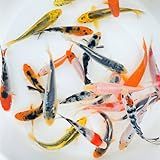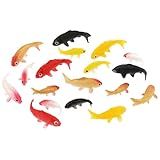Best Fish Supplies for Fall to Buy in January 2026

TetraPond Koi Vibrance Soft Sticks, Floating Pond Fish Food for Koi Fish and Ornamental Goldfish, 2.42 Pounds
- BOOST FISH HEALTH WITH A BALANCED DAILY DIET FOR ENERGY AND LONGEVITY.
- EASY-TO-EAT SOFT STICKS PROMOTE BETTER DIGESTION FOR HAPPY FISH.
- CLEAR WATER WITH LESS WASTE USING OUR HIGH-QUALITY NUTRITIOUS FOOD.



Toledo Goldfish Standard Fin Koi, Variety of Colors and Patterns - Beautiful Live Fish Perfect for Ponds, Tanks, and Aquariums - 3-4 Inches, 20 Count
- ENHANCE PONDS WITH STUNNING COLORS & PATTERNS OF STANDARD FIN KOI.
- MIX KOI WITH GOLDFISH FOR AN EXOTIC AND VIBRANT WATER GARDEN.
- HEALTH-CERTIFIED, USA-BORN KOI FROM A TRUSTED FAMILY-OWNED FARM.



Tetra Pond Sticks, Koi Fish & Goldfish Food, Soft Sticks, Easy to Digest Floating Pond Fish Food, 3.53 ounces
- BOOSTS ENERGY AND HEALTH FOR VIBRANT KOI AND GOLDFISH.
- SOFT STICKS ENSURE EASY EATING AND DIGESTION FOR ALL FISH.
- PROMOTES CLEAR WATER WITH LOW WASTE FROM HIGH-QUALITY FOOD.



TetraPond Variety Blend, Pond Fish Food, for Goldfish and Koi Yellow 2.25 Pound (Pack of 1)
- DAILY STAPLE FOR VIBRANT KOI AND GOLDFISH OF ALL SIZES.
- VARIED DIET WITH POND STICKS FOR OPTIMAL HEALTH AND COLOR.
- SOFT, EASY-TO-DIGEST STICKS PERFECT FOR ALL POND FISH.



X Hot Popcorn 40Pcs Mini Koi Fish Mini Goldfish Figurines Miniature Koi Fish Tiny Goldfish Fairy Garden Supplies
- LIFELIKE KOI FISH DESIGN ENHANCES ANY MINI FAIRY GARDEN PROJECT.
- IDEAL FOR DIY CRAFTS, ADDING CHARM TO MICRO LANDSCAPING CREATIONS.
- PERFECT GIFT FOR ARTS AND CRAFTS ENTHUSIASTS WHO LOVE MINIATURES!



KALIONE Mini Koi Fish 20 Pcs Goldfish Figurines Miniature Tiny Carps Garden Supplies, Plastic Fish Figures Small Goldfish Miniature Carp Ornament Garden Decor
-
LIFELIKE DESIGN: EXQUISITE CRAFTSMANSHIP ADDS CHARM TO ANY PROJECT.
-
VERSATILE SIZES: MINIATURE CARP IN VARYING LENGTHS FOR CREATIVE DECOR.
-
DURABLE QUALITY: HIGH-QUALITY PLASTIC ENSURES LONGEVITY AND VIBRANT COLORS.


Autumn is a great time to add fish to your pond. It's cool so water holds more oxygen and that is important when you consider a koi or goldfish has to be subjected to a little cramped bagged environment for an hour or two while you transport them. It's also the time of year when koi and goldfish are more plentiful and prices are generally more competitive. Many koi clubs hold their annual koi shows during the fall and sellers who usually are not accessible are in town with koi fresh from Japan and from the breeders. Fall is the end of pond season. Unless you are in Florida or Southern California where the seasons do not change as dramatically as the rest of the country, water garden centers and pond stores are trying to whittle down their live stock for the winter so deals can be found more readily.
Parasites and New Koi and Goldfish
Chances are - wherever you purchase your fish - you will run into a problem that runs amuck in the industry. You will probably purchase fish that have parasites. When we sell fish we quarantine them for a couple of weeks and treat them for parasites and bacteria so you don't take home more than what you bargain for. Unfortunately the rest of the world does not think the way we do. They'll be millionaires while we are "just getting by" because we have a conscience and do not want to see fish die because of something as simple as treating for parasites. Treating the fish and taking any losses of those that die during treatment is costly. If you find a place that TRULY does quarantine and treat before they sell fish, treasure that relationship! Most fish dealers will not clean up their fish before selling them so it is important that you take the responsibility to do it yourself - before you place them into your pond and infect your current (and beloved) population. If you do not have quarantine facilities (and most people do not) we would strongly advise to treat your whole pond with the new fish in it once you've bought all the fish you are going to buy for a while.
It is simple to treat for parasites and not as expensive as losing koi and goldfish. Flukes, Fish Lice and Anchor Worm are killed by the same type of treatment but what kills these parasites will not kill the others (ie. Chilodinella, Ick, etc.). Unless you have a microscope and are able to do a mucus scraping to find out exactly which parasites are present you are forced to assume they have at least one parasite from both groups. Normally for this we suggest using our Parasite Pak. It includes the two different treatments needed for the two different groups of parasites and directions on how to use them. Instead of the Parasite Pak, because it's Autumn, we are changing our recommendation to another kind of treatment - Prazi Pond and ProForm C. Both work in lower water temperatures and that makes them ideal for this time of year and for early spring as well.
Prazi Pond kills Flukes, Anchor Worm and Fish Lice. ProForm C kills the rest. NEVER treat the pond (or quarantine tank) with both at the same time! Make sure one treatment is totally finished before you begin on the other. It really doesn't matter which one you do first.
Viruses and New Fish
Parasites are not the only thing that new fish can bring into an existing population. Although it's rare, a new fish can bring in a nasty virus that can kill your fish. A virus will make itself known in warm waters (above 72 to 75 degrees) and can lay dormant during the fall or any time the water is cool only to show up in the spring when the waters heat up. This is not such a problem now that many of the koi imported from overseas go through a certification process - but it still can happen. If at all possible quarantine any new arrivals (especially imports without certification) for two weeks in a heated environment while, of course, treating for parasites.
